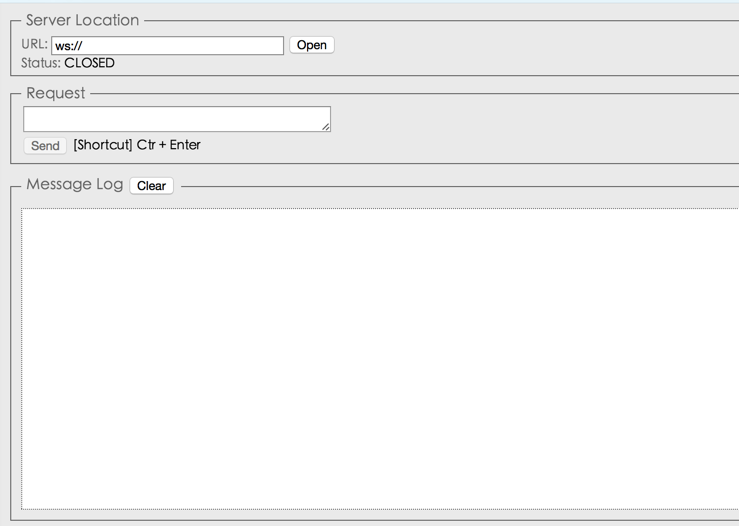标签:
介绍
现很多网站为了实现即时通讯,所用的技术都是轮询(polling)。轮询是在特定的的时间间隔(如每1秒),由浏览器对服务器发出HTTP request,然后由服务器返回最新的数据给客服端的浏览器。这种传统的HTTP request 的模式带来很明显的缺点 – 浏览器需要不断的向服务器发出请求,然而HTTP request 的header是非常长的,里面包含的数据可能只是一个很小的值,这样会占用很多的带宽。
而最比较新的技术去做轮询的效果是Comet – 用了AJAX。但这种技术虽然可达到全双工通信,但依然需要发出请求。
在 WebSocket API,浏览器和服务器只需要要做一个握手的动作,然后,浏览器和服务器之间就形成了一条快速通道。两者之间就直接可以数据互相传送。
依赖:
Tomcat 7 或者 J2EE7
<dependency> <groupId>org.apache.tomcat</groupId> <artifactId>tomcat-websocket-api</artifactId> <version>7.0.47</version> <scope>provided</scope> </dependency> <dependency> <groupId>javax</groupId> <artifactId>javaee-api</artifactId> <version>7.0</version> <scope>provided</scope> </dependency>
注意:早前业界没有统一的标准,各服务器都有各自的实现,现在J2EE7的JSR356已经定义了统一的标准,请尽量使用支持最新通用标准的服务器。
详见:http://www.oracle.com/technetwork/articles/java/jsr356-1937161.html
http://jinnianshilongnian.iteye.com/blog/1909962
我是用的Tomcat 7.0.57 + Java7
必须是Tomcat 7.0.47以上
详见:http://www.iteye.com/news/28414
ps:最早我们是用的Tomcat 7自带的实现,后来要升级Tomcat 8,结果原来的实现方式在Tomcat 8不支持了,就只好切换到支持Websocket 1.0版本的Tomcat了。
主流的java web服务器都有支持JSR365标准的版本了,请自行Google。
用nginx做反向代理的需要注意啦,socket请求需要做特殊配置的,切记!
Tomcat的处理方式建议修改为NIO的方式,同时修改连接数到合适的参数,请自行Google!
服务端不需要在web.xml中做额外的配置,Tomcat启动后就可以直接连接了。
import com.dooioo.websocket.utils.SessionUtils;
import org.apache.commons.logging.Log;
import org.apache.commons.logging.LogFactory;
import javax.websocket.*;
import javax.websocket.server.PathParam;
import javax.websocket.server.ServerEndpoint;
/**
* 功能说明:websocket处理类, 使用J2EE7的标准
* 切忌直接在该连接处理类中加入业务处理代码
* 作者:liuxing(2014-11-14 04:20)
*/
//relationId和userCode是我的业务标识参数,websocket.ws是连接的路径,可以自行定义
@ServerEndpoint("/websocket.ws/{relationId}/{userCode}")
public class WebsocketEndPoint {
private static Log log = LogFactory.getLog(WebsocketEndPoint.class);
/**
* 打开连接时触发
* @param relationId
* @param userCode
* @param session
*/
@OnOpen
public void onOpen(@PathParam("relationId") String relationId,
@PathParam("userCode") int userCode,
Session session){
log.info("Websocket Start Connecting:"+ SessionUtils.getKey(relationId, userCode));
SessionUtils.put(relationId, userCode, session);
}
/**
* 收到客户端消息时触发
* @param relationId
* @param userCode
* @param message
* @return
*/
@OnMessage
public String onMessage(@PathParam("relationId") String relationId,
@PathParam("userCode") int userCode,
String message) {
return"Got your message ("+ message +").Thanks !";
}
/**
* 异常时触发
* @param relationId
* @param userCode
* @param session
*/
@OnError
public void onError(@PathParam("relationId") String relationId,
@PathParam("userCode") int userCode,
Throwable throwable,
Session session) {
log.info("Websocket Connection Exception:"+ SessionUtils.getKey(relationId, userCode));
log.info(throwable.getMessage(), throwable);
SessionUtils.remove(relationId, userCode);
}
/**
* 关闭连接时触发
* @param relationId
* @param userCode
* @param session
*/
@OnClose
public void onClose(@PathParam("relationId") String relationId,
@PathParam("userCode") int userCode,
Session session) {
log.info("Websocket Close Connection:"+ SessionUtils.getKey(relationId, userCode));
SessionUtils.remove(relationId, userCode);
}
}
工具类用来存储唯一key和连接
这个是我业务的需要,我的业务是服务器有对应动作触发时,推送数据到客户端,没有接收客户端数据的操作。
import javax.websocket.Session;
import java.util.Map;
import java.util.concurrent.ConcurrentHashMap;
/**
* 功能说明:用来存储业务定义的sessionId和连接的对应关系
* 利用业务逻辑中组装的sessionId获取有效连接后进行后续操作
* 作者:liuxing(2014-12-26 02:32)
*/
public class SessionUtils {
public static Map<String, Session> clients = new ConcurrentHashMap<>();
public static void put(String relationId, int userCode, Session session){
clients.put(getKey(relationId, userCode), session);
}
public static Session get(String relationId, int userCode){
return clients.get(getKey(relationId, userCode));
}
public static void remove(String relationId, int userCode){
clients.remove(getKey(relationId, userCode));
}
/**
* 判断是否有连接
* @param relationId
* @param userCode
* @return
*/
public static boolean hasConnection(String relationId, int userCode) {
return clients.containsKey(getKey(relationId, userCode));
}
/**
* 组装唯一识别的key
* @param relationId
* @param userCode
* @return
*/
public static String getKey(String relationId, int userCode) {
return relationId +"_"+ userCode;
}
}
推送数据到客户端
在其他业务方法中调用
/**
* 将数据传回客户端
* 异步的方式
* @param relationId
* @param userCode
* @param message
*/
public void broadcast(String relationId, int userCode, String message) {
if (TelSocketSessionUtils.hasConnection(relationId, userCode)) {
TelSocketSessionUtils.get(relationId, userCode).getAsyncRemote().sendText(message);
} else {
throw new NullPointerException(TelSocketSessionUtils.getKey(relationId, userCode) +"Connection does not exist");
}
}
我是使用异步的方法推送数据,还有同步的方法
详见:http://docs.oracle.com/javaee/7/api/javax/websocket/Session.html
var webSocket = null;
var tryTime = 0;
$(function () {
initSocket();
window.onbeforeunload = function () {
//离开页面时的其他操作
};
});
/**
* 初始化websocket,建立连接
*/
function initSocket() {
if (!window.WebSocket) {
alert("您的浏览器不支持websocket!");
return false;
}
webSocket = new WebSocket("ws://127.0.0.1:8080/websocket.ws/"+ relationId +"/"+ userCode);
// 收到服务端消息
webSocket.onmessage = function (msg) {
console.log(msg);
};
// 异常
webSocket.onerror = function (event) {
console.log(event);
};
// 建立连接
webSocket.onopen = function (event) {
console.log(event);
};
// 断线重连
webSocket.onclose = function () {
// 重试10次,每次之间间隔10秒
if (tryTime < 10) {
setTimeout(function () {
webSocket = null;
tryTime++;
initSocket();
}, 500);
} else {
tryTime = 0;
}
};
}
其他调试工具
Java实现一个websocket的客户端
<dependency> <groupId>org.java-websocket</groupId> <artifactId>Java-WebSocket</artifactId> <version>1.3.0</version> </dependency>
import java.io.IOException;
import javax.websocket.ClientEndpoint;
import javax.websocket.OnError;
import javax.websocket.OnMessage;
import javax.websocket.OnOpen;
import javax.websocket.Session;
@ClientEndpoint
public class MyClient {
@OnOpen
public void onOpen(Session session) {
System.out.println("Connected to endpoint:"+ session.getBasicRemote());
try {
session.getBasicRemote().sendText("Hello");
} catch (IOException ex) {
}
}
@OnMessage
public void onMessage(String message) {
System.out.println(message);
}
@OnError
public void onError(Throwable t) {
t.printStackTrace();
}
}
import java.io.BufferedReader;
import java.io.IOException;
import java.io.InputStreamReader;
import java.net.URI;
import javax.websocket.ContainerProvider;
import javax.websocket.DeploymentException;
import javax.websocket.Session;
import javax.websocket.WebSocketContainer;
public class MyClientApp {
public Session session;
protected void start()
{
WebSocketContainer container = ContainerProvider.getWebSocketContainer();
String uri ="ws://127.0.0.1:8080/websocket.ws/relationId/12345";
System.out.println("Connecting to"+ uri);
try {
session = container.connectToServer(MyClient.class, URI.create(uri));
} catch (DeploymentException e) {
e.printStackTrace();
} catch (IOException e) {
e.printStackTrace();
}
}
public static void main(String args[]){
MyClientApp client = new MyClientApp();
client.start();
BufferedReader br = new BufferedReader(new InputStreamReader(System.in));
String input ="";
try {
do{
input = br.readLine();
if(!input.equals("exit"))
client.session.getBasicRemote().sendText(input);
}while(!input.equals("exit"));
} catch (IOException e) {
// TODO Auto-generated catch block
e.printStackTrace();
}
}
}
Chrome安装一个websocket模拟客户端

为了统一的操作体验,对于一些不支持websocket的浏览器,请使用socketjs技术做客户端开发。
标签:
原文地址:http://my.oschina.net/sphl520/blog/398382